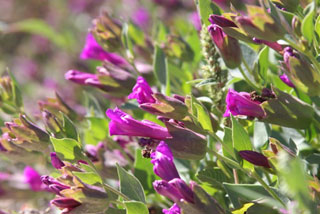Desert Four O'Clock in the Landscape

Diane Jones, Draggin' Wing Farm, Water-thrifty Plants for Idaho
Scientfic Name: Mirabilis multifloraCommon Name: Desert Four O'Clock
Description: Desert four o'clock is an herbaceous, very long-lived perennial. The plants die back to the ground during winter and new shoots emerge from a large underground woody root structure in late spring. Once emerged growth is rapid and ultimate size is very broad, up to 10 feet across by fall. The leaves are dark green, tinted with red, glossy, and attractive. The flowers are large, funnel-shaped, and magenta in color. The bloom period is long, June until hard frost in fall. This species needs space and is appropriate only for large beds.
Native Habitat: Desert four o’clock is native to all of the southwestern states and grows in harsh, dry conditions. It can found at elevations ranging from 2,100 to 7,500 feet where is grows with pinyon pine and junipers.
Cultural Requirement
Soil: Adapted to a range of soils, including those with high pH. Does well in heavy soil, if not over-watered, and also thrives in well-drained sandy or gravelly substrates.
Moisture Tolerance: This is a truly xeric plant and can thrive without irrigation, although it can withstand considerable supplemental irrigation (but not frequent saturation). With some supplemental irrigation, it will be more vigorous and grow larger.
Sun/Shade/Preference: Prefers full sun but also does well in the part-shade of small trees and shrubs.
Transplanting: Best transplanted when small. Does not tolerate extended periods in pots. In order to survive its first winter in the ground, desert four o’clock needs to be established in spring so it has time to develop its large, tuberous storage root.
Propagation: Propagate from seed. No cold stratification required. Plants develop rapidly and, if started early, will bloom profusely the first year.
Maintenance (pruning, fertilization, deadheading, division, irrigation, etc): In spring, remove the prodigious dead growth from the previous year. This is the only maintenance required unless large plants need periodic pruning to keep them in bounds. Occasional fertilization is okay, but probably not be needed.
Insect, disease, or other problems: Desert four o'clock has no serious pests or diseases. The large plants can be a haven for mice and voles due to heavy cover and a ready food supply when seeds start to drop.
Landscape Value
Use in the Landscape: Desert four o'clock is a wonderful addition to any large, xeric landscape. The plants fill in around shrubs and small trees where they provide color and a contrast in texture. The plants are very effective in large pavement islands. It is a marvelous plant in a naturalized landscape, but can be effective in a formal garden, as well.
Foliage: The somewhat succulent, pliable stems grow along the ground and increase in horizontal dimensions for as long as the weather is suitable. By the end of summer, the mounds of foliage are very large. The leaves are dark green and very attractive. New growth is often tinged with red.
Flower: Mature plants may have thousands of flowers at a given time. The blooms are medium to light purple, large, and trumpet-shaped. The flowers grow on short stems embedded in the foliage. The flowers have some tendency to close in late morning and reopen in late afternoon. However, they are attractive all day long.
Timing: June - October.
Color: Magenta.
Fruit: Two or more seeds grow in the papery husk formed by the mature sepals.
Form: Large mounds.
Texture: Moderately course.
Ultimate Size: Up to 2 feet tall and 5 to 10 feet across.
Rate of Growth: The foliage develops rapidly. If established early in the season, the plants usually bloom profusely the first summer.
Suggested Plant Partners: The sheer size of desert four o'clock will overwhelm most small-statured wildflowers and grasses. It works well as a filler between trees and shrubs such as Pinus monophylla, Juniperus scopulorum, Cercocarpus ledifolius, and Ericameria nauseosa. Tall xeric grasses, such as Sporobolus wrightii and Leymus cinereus also make good partner.
Availability: Commonly available as a potted plants at local or mail order native plant nurseries. Seed can be purchased from native plant seed suppliers.
Cultivars: None.
References:
Busco, J. and Morin, N.R. 2003. Native Plants for High Elevation Western Gardens. Fulcrum Publishing, Golden, Colorado.
Denver Water. 1996. Xeriscape Plant Guide: 100 Water-Wise Plants for Gardens and Landscapes. Fulcrum Publishing, Golden, Colorado.
Love, S.L., Noble, K., Robbins, J.A., Wilson, B. and McCammon, T. 2009. Landscaping with Native Plants. University of Idaho Bulletin #862.
Nold, R. 2008. High and Dry: Gardening with Cold Hardy Dryland Plants. Timber Press, Portland, Oregon.

